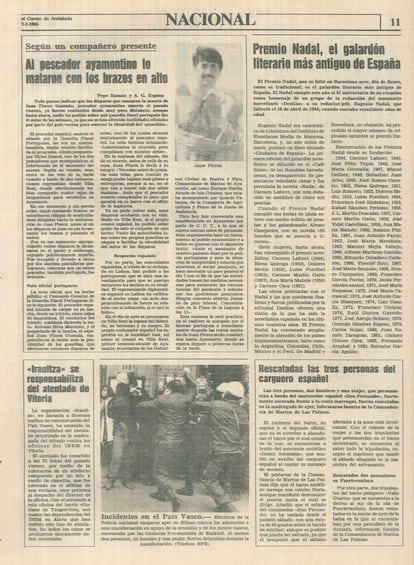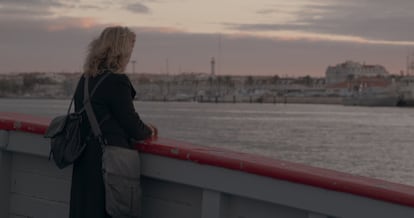Perhaps the only way to scrutinize the soul of the singer-songwriter Carlos Cano (Granada, 1946-2000) be through his songs. The folklore renovator, song singer and compromised jugglar, was present in each of its melodies. One of them, Maria the Portuguesethat sister Fado and Pasodoble, is a wound where the pain of the Andalusian fishing village breathes that will keep the memory of this fundamental poet of the transition and autonomy of Andalusia alive. “It is a song that has exceeded limits, has crossed borders and has transcended the creator himself.” With a faint voice, tasted by melancholy, one of the artist’s daughters, Amaranta Cano, recognizes in this musical icon “the true dimension” of a work of art when the umbilical cord cuts with its author and becomes “to the people”.
Maria the Portuguese It is now also the title of a documentary film signed by the filmmaker Eduardo Montero, with a script by Ángel del Río, which serves Amaranta Cano for the reunion with his father. “My father’s dimension at the popular level I really know her when she dies. The Carlos Cano Artist Documentary
“I can’t stand that he is dead and that his legacy is dead,” Amaranta Cano insists at the beginning of the footage. And in this effort to keep him alive, in the memory and musical history of this country, the daughter joins a trip to meet the father, with Maria the Portuguese As a medium. The filming of an expedition that also serves to rebuild the facts – some imagined, most real – in which Carlos Cano was inspired to write this classic.
Maria the Portuguese Carlos Cano firm in 1987 and belongs to his album Stay with the couplet. It has been versioned by many artists, fundamentally female voices, such as the great Fadista Amália Rodrigues, María Dolores Pradera, Passion Vega, Las Migas, Rozalén and Martirio, these last two present in the documentary. It is a hybridization of Fado, Main Caboverdiana, Copla and Pasodoble. But what is exactly narrated in Maria the Portuguese?
“The song says in a moment ‘and a shot sounded.’ Maria the Portuguese? guard Portuguese (border police) killed Juan Flores, a Spanish shellfish, in full mouth of the Guadiana River, suspecting illegal fishing and smuggling in the neighboring country: a woman unknown to the family, Maria, veiled the body all night, accompanied the coffin in the cemetery until the tomb and disappeared. Upon knowing the facts, Carlos Cano fabulated a love story.
The real woman, however, “was not called Maria or Portuguese,” explains the journalist. The chronicles of the time, collected in sepia -dyed newspaper leaves that custody Loli Flores, the daughter of the deceased fisherman, tell us about an event that almost causes a serious diplomatic crisis between Spain and Portugal and by which the entire town of Ayamonte went out to the street to ask for justice. After the judgments held in Vila Real de Santo Antonio, the guard José Antonio Nunes was convicted of reckless recklessness. Juan Flores left widow and two daughters, and his family only got 200,000 compensation pesetas.

From the enigmatic woman, however, nothing said the newspapers. Amaranta Cano visits Ayamonte and goes to the elders of the place, accustomed to watching old secrets and look the other way before the questions of the outsiders. It is when crossing the border to Vila Real do Santo António where Carlos Cano’s daughter is unmasking a woman who, according to the Portuguese neighbors, “did not leave anyone indifferent.”
“Where it happened left a ray of joy, a trail of light.” “It was Spanish, but it became ours,” recall this woman born in 1926 on the Spanish side of the border as Maria, but renamed Portugal with the name of Aurora. “A person who did not go unnoticed”, “a figure that imposed”, “with her red lips, her vital color” … “I woke up hatred among married women, because she went with men,” he even recognizes one of the geriatric workers where Aurora spent the end of her days, Aquejada de Alzheimer’s.
However, behind this fatal woman’s legend, Aurora was, and there has found Amaranta Cano the consensus, a woman who “understood the needs of the people, her financial difficulties, helped people, so she was so well known; she asked the ship’s patterns for the ships for the most needy fishermen,” explains in Portuguese a friend of the protagonist of the song of the song, It was not a romance, it was solidarity, because of the circumstances in which he died, injustice, to see the pain of a Spanish family on the border. ”
The documentary does not reveal if this woman could see her story recognized in the song of Carlos Cano, so known in the neighboring country for the tribute that the Andalusian artist makes to the Fado. “It is a musical genre that deeply fascinated my father, as much as its most emblematic author, Amália Rodrigues,” says Amaranta.
“Amália Rodrigues and Carlos Cano make up the story of the Iberian Union,” says Fadista Teresa Salgueiro, gathered in this documentary with other artists, such as Martyrdom, Rozalén, Antonio Chainho and Raúl Rodríguez. For the latter, the greatness of Maria the Portuguese He summarizes not only an inspiration, but the reunion of a daughter with his father as a symbol of survival of a legacy: “María He has that thing of the great works of art of turning a very local history into a universal fact, transplantable to so many countries that are related to the borders, where people want beyond administrative limits, the bridges skip and love each other without a passport. ”

